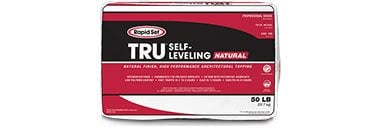Epoxy Terrazzo Installation
Epoxy terrazzo can be installed over most clean, properly prepared concrete slabs. Most manufacturers recommend applying a primer first to improve the epoxy/concrete bond.
Here's how epoxy terrazzo coatings are installed:
- When using multiple colors of terrazzo, installers fix metal divider strips to the slab with an epoxy adhesive.
- Then they mix the two-component epoxy resin with the decorative aggregate and pour the material onto the slab.
- Installers trowel the epoxy mixture to the top of the strips and then allow it to cure overnight (or at least 18 hours).
- The next day, they mechanically grind and polish the surface to reveal the natural beauty of the decorative aggregate.
- The final step is to apply a sealer, which makes the surface more resistant to water, chemicals, oil, grease, acids, and solvents.
Hire a pro: Find concrete floor contractors near me
Divider strips are made of zinc, brass, or other materials. The dividers not only delineate the design, they also are used at control and expansion joints in the concrete slab to help prevent the terrazzo topping from cracking due to joint movement. Thin and flexible, the divider strips can be bent by hand on the jobsite or preshaped in the factory into intricate designs.
Shop: Find terrazzo flooring & supplies
Typical Epoxy Floors Installation Locations
Virtually indestructible, epoxy terrazzo is ideal for commercial, industrial, and institutional facilities, especially where durability, longevity, and minimal maintenance are crucial.
"Epoxy terrazzo is often installed in major airports, train stations, arenas, institutions, and schools anywhere you have a mass of people walking on the floor and you want a decorative surface that's easy to maintain," says Cain.
Because epoxy terrazzo is chemical and stain resistant, the material is also ideal for chemical plants and food processing areas. It's equally well suited for sanitary environments, such as hospitals and health care facilities, because of its nonporous, joint-free surface.
And, of course, the color and design versatility of epoxy terrazzo makes it a popular choice for decorative flooring installations, especially in high-traffic retail facilities.
 Mica Flake
Provides the look of terrazzo or granite floors
Mica Flake
Provides the look of terrazzo or granite floors
 CPS G-170 Electric
17" Floor Grinder 230 volt ($7,600)
CPS G-170 Electric
17" Floor Grinder 230 volt ($7,600)
 Self-Leveling Polishable
Self-Leveling Polishable Overlay Long working time, smooth surface, polishable topping
Here are some of the places where epoxy terrazzo surfaces are being installed:
- Stores and shopping malls
- Airports
- Educational institutions
- Food processing and preparation areas
- Cafeterias
- Chemical processing plants
- Commercial kitchens
- Convention centers
- Corridors
- Theme parks
- Hospital operating rooms
- Laboratories
- Pharmaceutical plants
- Wastewater treatment facilities
- Kitchen countertops
Concrete Terrazzo Floors - How to Become a More Qualified Terrazzo Contractor
Epoxy terrazzo is a highly artistic floor finish, so it's important to homeowners to hire a qualified, experienced contractor for the job to get the best results. One way to ensure consideration for any job is to join NTMA (National Terrazzo & Mosaic Association).. This nonprofit trade group requires members to be proficient in all types of terrazzo systems and to abide by its stringent quality-assurance standards.
"To qualify as an NTMA contractor member, installers must demonstrate the ability to install high-quality terrazzo," says Hardy. "We do job inspections of terrazzo work they've performed, and we require positive references from architects and general contractors they've worked with. It's a pretty tough process, but it does ensure proper installation of this handcrafted product."
Cain agrees that installing epoxy terrazzo is a specialized skill. "You've got to be trained to do it from start to finish not only in placing the terrazzo, but also in the grinding and finishing, which can be more important than the installation," he says. "People expect terrazzo to be an absolutely smooth, highly polished surface."




